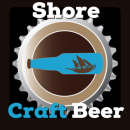Sometimes we get so caught up in celebrating the quality and variety of the beers to which we have access, it is easy to forget that craft beer is not just about the beer. Spend enough time in the brewery tap rooms, however, and you easily can be reminded how much craft beer enthusiasts rely on one another’s presence, and how that presence reinforces the craft beer culture. Craft beer is a great uniter, which is easy to see in places like the Mispillion River Brewing facility in Milford, Del.
What sets the Shore apart is the fact that location still isn’t too limiting factor in the craft beer industry, as the success of places like Mispillion River Brewing demonstrate. MRB is in an industrial park less than a mile or so from Route 113, but seemingly in complete isolation. I don’t know how many Saturday nights you’ve spent driving around industrial parks but they tend to have a deserted, apocalyptic feel. After winding through dark roads and making the final turn onto Mullet Run St. (we’re gonna assume this is named for the fish, not the hairstyle), the brewery is a beacon.
It is in the middle of rural Delaware and it is utterly packed, so much so that it feels a little roadhouse-y. But the isolated spark of excitement in the dark is where comparisons to a roadhouse end. The people have come for good beer, and, increasingly, that means there is no demographic. Or, rather, it is starting to look as if craft beer drinkers are their own demographic (which is one of the things that is driving the big beer companies, and lots of other marketers a little nuts).
Picture
Typically, craft beer drinkers aren’t typical.
My favorite aspect of the craft beer demographic is more than the fact that is mostly is ageless. It also is increasingly genderless. Women are a part of the craft beer culture, not an object to promote it, which might be the reason so many women are so comfortable in craft breweries.
Michelle Knechel, a middle-aged woman and recent convert to porters, and particularly, Praetor, the Imperial Porter from MRB, is among the regulars at the taproom.
She used to drink lighter beers. Her husband Adam is an avid homebrewer who makes a little bit of everything. The fact that a 7.5 percent porter was her gateway beer to that style says a lot about the sea change the access to some many great beers has created.
The fact that the tap room is not a bar is one of the reasons she is drawn here.
“It just feels like home,” she said.
There are only two discernible differences between a brewery and a bar, but they are salient. The first is the lack of demographic I just mentioned. If you don’t want to go to an old man bar or a frat boy bar or a college bar, go to a brewery. The entertainment is going to be for you as a beer drinker, as is the atmosphere.
Picture
Owner Megan Williams hustling beers around the bar at Mispillion River Brewing.
The other difference is that a craft brewery is not about selling beer, it’s about making beer. A fine distinction, it’s true, but an important one. The attitude that they are making things with their hands pervades the entire culture. You get some insight into the days when the local tavern was the center of community life, more about providing a gathering place than a place to get tanked or to hook up.
For Megan Williams, who owns the brewery with her husband Eric, it is this approach that always was front and center when they started MRB a little more than a year ago.
“We really want to be that community watering hole,” she said. “So we try and have something for everybody.”
Certainly that means having accessible beers on tap (MRB’ is a Belgian Pale Ale called Beach Bum Joe), but it also means making the place accessible. Like an increasing number of places, MRB has a food truck on site. Outside, there’s a fire pit that encourages hanging out and making connections. The atmosphere here, and at many of the region’s craft breweries, is the demographic killer. Craft beer is the opener, strangers ask one another what they’re drinking and why. After that, it’s all about being part of the same culture, not the same demographic.
